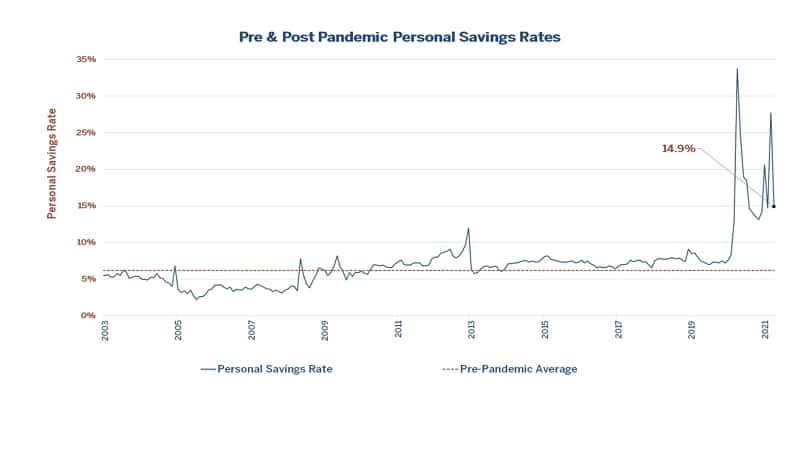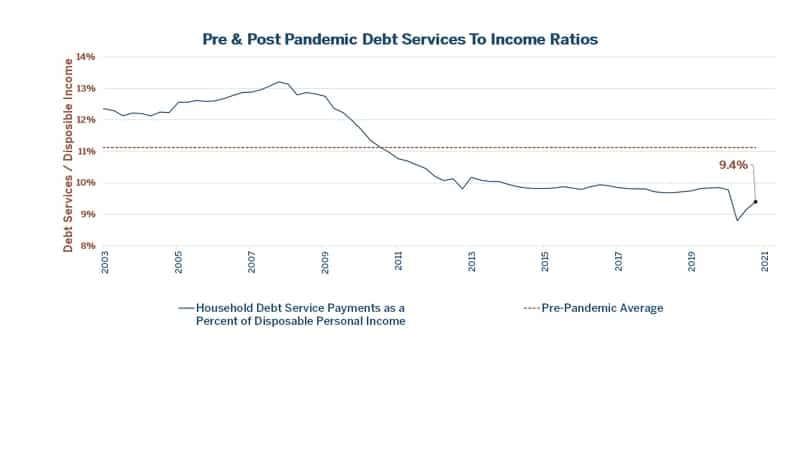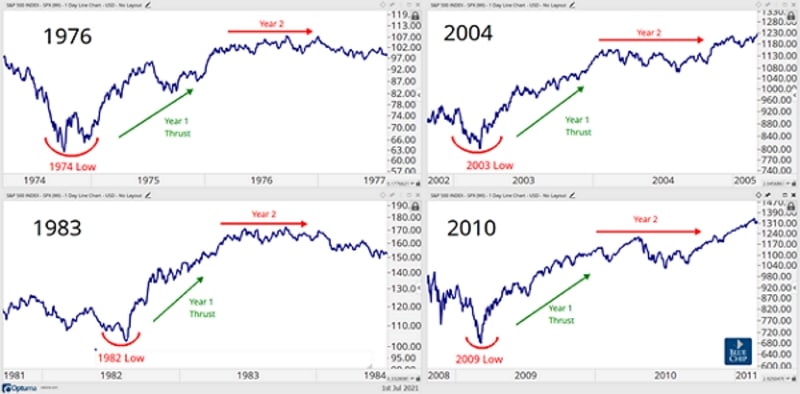Welcome to the third quarter. The sun is shining, the smell of grass clippings abounds, and the grills are fired up. As we digest the mixed signals we are receiving as local economies rise from the ashes, we have identified three key themes to watch in the third quarter of 2021:
Picking Up Speed
The economic restart is officially here. After tremendous fiscal stimulus and a simultaneous pullback in spending, American consumers saved roughly $2 trillion during the pandemic.*

Today, individuals find themselves in a fantastic position from the perspective of household finances, which is a dramatically different picture than was painted upon emergence from the global financial crisis. As broad vaccinations have allowed local economies to reopen, consumers are ready to spend given an average savings rate of 17.5% over the last 12 months and household debt services representing a modest 9.4% of disposable income.

There remains a healthy amount of pent-up demand which, in tandem with supply side issues, has placed inflation readings such as the Consumer Price Index (CPI) in the fast lane. While prices have undoubtedly risen (albeit off of a base that is skewed to the downside), we can’t use one-dimensional year-over-year price measurements to make a call on what are nontraditional inflation dynamics. For the COVID-19 recession, demand was artificially suppressed, and supply followed as companies reduced capacity in an attempt to maintain margins. While the demand side rebound has been more akin to turning a spigot, reinvigorating the supply side is more accurately portrayed as turning a large boat – it takes time. The inability of large firms and small businesses to staff up is one of our primary concerns with regards to inflation going forward inflation piece here for additional color), but we also see deflationary forces coming into play in both the short-term and the long-term. Supply chain disruptions will likely abate throughout the remainder of the year, and the increasing prominence of technology has introduced a massive deflationary force into the world economy. As automation and robots continue to infiltrate factories, back-office processes, and restaurants, technology puts downward pressure on wages, resulting in a lack of spending power and thus decreased demand.
While we have seen some flattening of the yield curve (i.e. short-term yields rising and/or long-term yields falling), longer-term yields are not flashing any inflationary warnings signs. The yield on the 10-year U.S. Treasury, which is influenced by inflation expectations, can be dissected by splitting the full-time horizon into two distinct periods: the first 5 years, and the second 5 years. The 5-year breakeven inflation rate applies to the shorter-term portion, while the 5-year, 5-year forward inflation expectation rate (5-year inflation expectation, 5-years from today) covers the back half of the 10-year. Although these measures have ticked up on the back of recent “Fed Speak”, we are only marginally ahead of the Federal Reserve’s 2% long-term target.

Quality In Focus
Remember growth? Growth stocks are those that are viewed favorably given their potential for future earnings to support what is a lofty valuation today. We can’t blame you if you had forgotten, as the beginning of this year was not kind to growth-oriented equities. From the start of the year through close of business May 13th, value stocks (companies that are currently trading at a discount and have potential to re-rate higher) charged forward by way of 14.1% outperformance relative to growth**. The trend has reversed, and growth finds itself in a position of market leadership for the first time this year. While the growth vs. value tug-of-war may continue, one thing is likely: a focus on competitively insulated, well-capitalized companies remains ripe for this environment. After a dramatic rebound in deeply depressed cyclical value names (think energy, materials, financials), companies will now need to prove their worth via continued earnings and free cash flow improvement to get a leg higher. Companies that can weather the storm that comes with supply chain bottlenecks and increased input prices will likely be afforded a greater premium in the coming months. The beauty of this focus on “quality” is that neither growth nor value have a monopoly on attractive companies when viewed through such a lens. Case in point: on average, companies that reside in both the Russell 1000 Value and Russell 1000 Growth Indexes have screened more attractively on select quality metrics than companies that are only found in the value or growth index:

Heading into Q3, we don’t see the need to handicap portfolios by making a call on a single equity style, especially given mixed signals in terms of which area of the market will maintain market leadership going forward. A focus on quality will likely prove more prudent.
Take A Breath
This call for prudence is grounded in history, as volatility may be headed higher before it trends lower. Companies that have flexibility to distribute capital through sustainable free cash flow are more attractive in this type of environment, as year two of a bull market has typically exhibited more of a sideways trading environment as opposed to the previous year’s large thrust higher. This phenomenon has been seen in numerous market cycles in the past. See examples from 1976, 1983, 2004, and 2010 below:

Investors should take a deep breath, as there is no reason to hit the panic button. It is natural for the market to take a breather in the second year of a new market cycle, and this breather allows companies a chance to prove that they are worthy of higher multiples. Income generation also remains a prominent theme amid a sideways chop. However, U.S. treasury yields remain suppressed, spreads among U.S. investment grade corporate bonds are at their lowest dating back over a decade, and U.S. high yield spreads haven’t been this narrow since 2018***. Given the above, we think dividend-paying equities provide an attractive value proposition, and should also help investors remain at ease if volatility picks up.
Your Bottom Line
In summary, we are optimistic about the pace of the economic restart in the U.S. While some inflationary readings have been running hot, in the long run, supply chain resolution and deflationary forces will likely take hold. Market leadership will likely continue to toggle, and there is potential for sideways trading based on historical evidence. Check back here for updates and additional thoughts as we progress through the back half of 2021.
Download a copy of this report by clicking the icon below.
- *Source: Federal Reserve Bank of St. Louis. Data shown from 1 January 2003 – 31 May 2021 (31 December for Household Debt Services / Disposable Income). Pre-pandemic average reflects the period from 1 January 2003 – 31 December 2019.
- **Value is represented by the Russell 1000 Value Index, and Growth is represented by the Russell 1000 Growth Index. Returns are sourced from Bloomberg.
- ***Sources: 10-Year Treasury Constant Maturity Rate, ICE BofA U.S. High Yield Index, and ICE BofA U.S. Investment Grade Index with data from the Federal Reserve Bank of St. Louis.
View more Blue Chip Quarterly Edge updates here.
Expressions of opinion are as of 30 June 2021 and are subject to change without notice. Any information is not a complete summary or statement of all available data necessary for making an investment decision and does not constitute a recommendation. The information has been obtained from sources considered to be reliable, but we do not guarantee that the foregoing material is accurate or complete. Every investor’s situation is unique, and you should consider your investment goals, risk tolerance and time horizon before making any investment. Prior to making an investment decision, please consult with your financial advisor about your individual situation. Past performance does not guarantee future results. Investing involves risk and you may incur a profit or loss regardless of strategy selected. There is no guarantee that any statements, opinions or forecasts provided herein will prove to be correct.
BCP_Q3_2021_Quarterly_Edge.pdf

